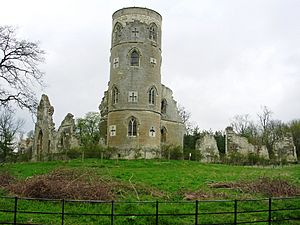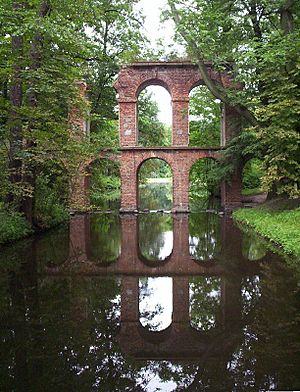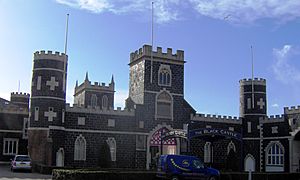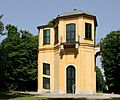Folly facts for kids
A folly is a special kind of building that is usually built just to look nice. Most buildings are made to give people shelter or a place to live. But follies are different! They are like giant decorations and don't have a normal use.
Follies were first built to add interesting touches to big parks and large estates. The word "folly" here means something fun or light-hearted, not something silly or a bad idea.
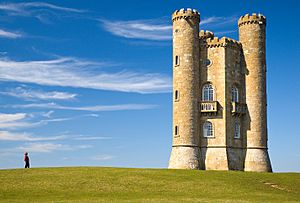

Contents
What Makes a Folly a Folly?
Follies usually have these features:
- They are buildings or parts of buildings. This makes them different from other garden decorations like sculptures.
- They are only for decoration. Often, they look like a building made for a real purpose, but it's just pretend.
- They are built on purpose. Follies are planned and built specifically to be decorations.
- They often have unusual designs. While not always, follies often stand out because they look unique or strange.
- They might look fake. A great example is a fake ruin. It looks like an old, broken building, but it was actually built that way from the start!
In England, these buildings are sometimes called "eye-catchers." This name shows that their main job is to catch your eye and look pretty.
Follies and Similar Buildings
Follies are part of a group of buildings that are imaginative and not always practical. Sometimes it's hard to decide if a building is truly a folly. But here are some types that are related but different:
- Fantasy and novelty buildings are almost the opposite of follies. Follies often look like real buildings but aren't used. Novelty buildings *are* used, but they have really wild shapes. For example, many shops in America shaped like everyday items (like a giant shoe) are not follies because they are used as shops.
- Unusual structures might seem like follies, but just being strange doesn't make a building a folly. Many castles or large houses are very unique, but they are built to be lived in, so they aren't follies.
- Some buildings are called "follies" because they didn't work out as planned. Their design might have been foolish, but in architecture, they aren't true follies because they *were* meant to be useful.
- Amusement parks and big fairs often have amazing and strange buildings. Some of these are follies, and some are not. The difference is how they are used. Shops and restaurants in these parks might look very odd, but they are not follies because they serve a purpose. However, fake structures that are just for decoration are follies.
History of Follies
Follies started as decorations on large estates in the late 1500s and early 1600s. But they became very popular in the next two centuries. Many old estates already had beautiful ruins of old monasteries or Roman villas. Estates without these old ruins would build their own fake versions to look romantic.
These buildings were often named after the person who ordered or designed them, like "[Name]'s Folly." However, very few follies were completely useless. Many actually had a purpose at first, like hunting towers, which was later forgotten. The Folly Fellowship, a group that celebrates these buildings, says that follies are often misunderstood.
Follies are often found in the parks or large grounds of big houses and stately homes. Some were even built to look partly ruined on purpose. They were especially popular from the late 16th century to the 18th century.
Famine Follies
The Irish Potato Famine (1845-1849) led to the building of several follies in Ireland. At that time, many people believed that the government should not interfere much with the economy or provide welfare. They thought that giving money without work was wrong. However, hiring people for useful projects would take jobs away from existing workers.
So, to give people work without taking jobs, "famine follies" were built. These included roads that went nowhere, walls around estates, and piers built in the middle of bogs (wetlands). These projects gave people jobs during a very difficult time.
Examples of Follies Around the World
Follies can be found all over the world, but there are many in Great Britain.
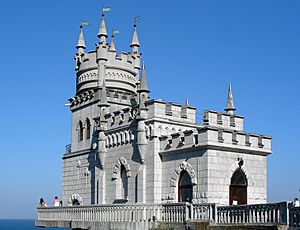
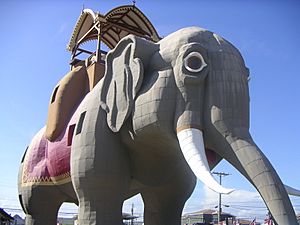
France
- Désert de Retz, a folly garden near Paris (18th century)
- Parc de la Villette in Paris has many modern follies by architect Bernard Tschumi.
- Ferdinand Cheval in Châteauneuf-de-Galaure built what he called an Ideal Palace, a famous example of unique, self-taught architecture.
Hungary
India
- Overbury's Folly, Thalassery, Kerala
Ireland
Italy
- The Bomarzo Gardens
Russia
- Ruined towers in Peterhof, Tsarskoe Selo, Gatchina, and Tsaritsino
- Creaking Pagoda and Chinese Village in Tsarskoe Selo
- Dutch Admiralty in Tsarskoe Selo
Ukraine
- Swallow's Nest near Yalta
United Kingdom
- Ashton Memorial, Lancaster, England
- Beckford's Tower, Somerset, England
- Broadway Tower, The Cotswolds, England
- Bettisons Folly, Hornsea, England
- Black Castle Public House, Bristol, England
- The Cage at Lyme Park, Cheshire, England
- The Castle at Roundhay Park, Leeds, England
- Clavell Tower, Dorset, England
- Clytha Castle Monmouthshire
- The Caldwell Tower, Lugton, Renfrewshire, Scotland.
- Dunmore Pineapple, Falkirk, Scotland
- Faringdon Folly, Faringdon, Oxfordshire
- Flounder's Folly, Shropshire, England
- The Folly Tower at Pontypool, Wales
- Fonthill Abbey, Wiltshire, England
- Fort Belvedere, Surrey, England
- Freston Tower, near Ipswich, Suffolk
- Gothic Tower at Goldney Hall, Bristol
- The Great Pagoda at the Royal Botanic Gardens, Kew, London
- Gwrych Castle, one of Europe's largest follies, Abergele, North Wales
- Hawkstone Park, follies and gardens in Shropshire, England
- Hume Castle. Berwickshire, Scotland
- King Alfred's Tower, Stourhead, Wiltshire, England
- McCaig's Tower, Oban, Scotland
- Mow Cop Castle, Cheshire, England
- National Monument, Edinburgh, Scotland
- Old John, Bradgate Park, Leicestershire, England
- Penshaw Monument, Penshaw, Sunderland, England
- Perrott's Folly, Birmingham, England
- Pope's Grotto, Twickenham, south west London, England.
- Portmeirion, Wales
- Rushton Triangular Lodge, Northamptonshire (16th century)
- Severndroog Castle, Shooter's Hill, south-east London
- Stowe School has several follies in the grounds
- Sway Tower, New Forest, England
- Tattingstone Wonder, near Ipswich, Suffolk
- The Temple near Castle Semple Loch, Renfrewshire, Scotland.
- Wentworth Follies, Wentworth, South Yorkshire
- Williamson's tunnels, probably the largest underground folly in the world, Liverpool, England
United States
- Belvedere Castle, New York City
- Lawson Tower, Scituate, Massachusetts
- Lucy the Elephant, Margate City, New Jersey
- Bishop Castle, outside of Pueblo, Colorado
- Körner's Folly, Kernersville, North Carolina
Images for kids
-
Broadway Tower, Worcestershire, England
-
The Dunmore Pineapple in Scotland
-
Built in 1912, the Swallow's Nest is one of the Neo-Gothic châteaux fantastiques in Crimea.
-
The Pantheon at Stourhead estate
-
The Temple of Philosophy at Ermenonville in Oise, France
-
Roman ruin, Schönbrunn, Austria
-
The minaret in the (Lednice–Valtice Complex, Czech Republic) was built by the House of Liechtenstein during 1797–1804
-
Conolly's Folly, County Kildare, Ireland, built to provide employment during the Irish famine of 1740–41
-
Lija Belvedere Tower in Malta
-
El Capricho, in Comillas, Spain
-
Rushton Triangular Lodge, Northamptonshire, England, built in the late 16th century to symbolise the Holy Trinity
-
The Beacon: One of the remaining follies at Staunton Country Park originally commissioned by George Thomas Staunton and designed by Lewis Vulliamy
-
Paxton's Tower, Carmarthenshire
-
Chateau Laroche, just north of Loveland, Ohio
See also
 In Spanish: Capricho (arquitectura) para niños
In Spanish: Capricho (arquitectura) para niños


